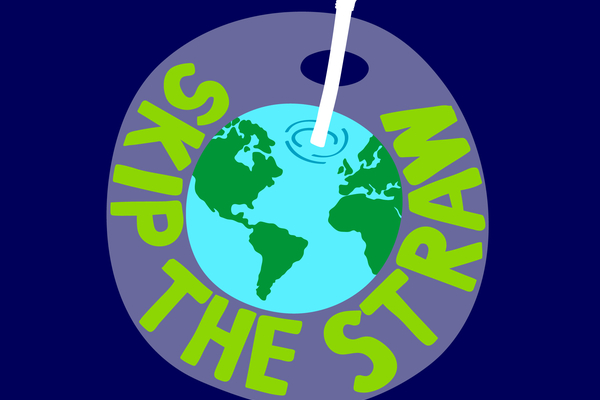The next time you hit the drive-through for lunch or a quick afternoon pick-me-up, you might want to think twice before using the plastic straw that inevitably came with your drink. February 26 is National Skip the Straw Day, an event held the fourth Friday of every February to raise awareness about how many straws end up as litter and how these straws ultimately affect our environment.
Plastic straws have developed a bit of a bad reputation lately, the focus of laws and mandates to regulate and — ultimately — eliminate or at least greatly reduce their use. In July 2018, Seattle became the first major U.S. city to ban plastic straws, but others laws have followed suit, as Business Insider reports. Washington, D.C., also has enacted a ban on straws and plastic stirrers and, in California, sit-down restaurants cannot provide straws to customers unless they are requested.
So why is the plastic straw the newest target? In large part because most of us don’t need them — for most able-bodied people they are simply a convenience — and we use a whole lot of them. A mega lot. It’s actually a ridiculous lot. Specific statistics about how many plastic straws Americans use are hard to come by, but the number likely falls somewhere between 170 million to 390 million per day, which amounts to between 63 billion and 142 billion per year, the New York Times reports.
And a lot of these straws don’t even make their way into the garbage but instead end up as litter on the streets, sidewalks, and gutters. In parks, forests, and beachs. In rivers, lakes, and oceans. They certainly aren’t alone, though. Single-use plastics — water bottles, utensils, cups, wrappers — are a major polluter of our planet, particularly our waterways. About 18 billion tons of plastic waste flows into Earth’s oceans each year, National Geographic reports. In fact, only about 20 percent of all plastic is recycled. Plastic recycling rates are highest in Europe, where about 30 percent is recycled. In the United States, only 9 percent of plastic is recycled.
Think Globally, Act Locally
The focus on how plastics, including throwaway straws and other plastic items, affect our waterways primarily centers on the world’s oceans, but plastic pollution is a problem locally as well. And what we do locally eventually affects the oceans. “It’s absolutely a problem right here in our own backyards,” said Tina Riley, a facility supervisor for the Forest Preserve District. Will County is rich in rivers, Riley said, and the water quality of our local waterways eventually has an impact on a much larger scale. “Our rivers directly connect to the oceans.”
On a global scale, the figures are even more astonishing. According to a study published in Science magazine in 2015, 192 countries with ocean coastline produced 275 million metric tons of plastic waste in 2010. Of that, between 4.8 million metric tons and 12.7 million metric tons made its way into our oceans.
Here in local communities, Riley said plastic gets into the water in a few ways: from land, when it is blown into the water during storms or when it isn’t properly disposed of, and during and after heavy rain events when flooding occurs. “It’s coming from the land,” she said, adding that the notion that much of the trash found in the water comes from recreational boaters simply isn’t true. “The vast majority of stuff that’s in our waterways is from land.”
The Problem with Plastic
The problem with plastic litter making its way into our waters is that it’s permanent, Riley said. “It doesn’t go away,” she said. “It simply breaks down smaller and smaller.” You can see evidence of this just by walking along a local shoreline, looking at all the litter that has washed up. Some pieces might be fully intact — say a candy-bar wrapper or a water bottle — but others are just fragments of those once-whole pieces, little bits and pieces of plastic.
Eventually, the plastic breaks down into pieces that are no longer identifiable, then they become pieces so small you can’t even pick them up, Riley said. Eventually, you can’t even see the tiny pieces of plastic — called microplastics — but they are still there. Once the plastic is broken down into microscopic pieces, it is very difficult to remove it from water even using filtration, she said. And those small plastic pieces are being consumed by our wildlife. “(Aquatic animals and waterfowl) are consuming plastic, and then their food source (other aquatic animals) is also consuming plastic,” Riley said.
We’re ingesting these microplastics too, because it is everywhere, in our water supply and our food sources. And we haven’t even begun to fully understand what consuming all this plastic means for human health and for the health of wildlife species. “We don’t even know what the long-term impact will be,” Riley said.
How You Can Help
Properly disposing of plastic waste goes a long way to preventing it from becoming litter, but using less plastic is even more effective. That’s the whole point of National Skip the Straw Day. The problem with items like plastic straws is that they aren’t biodegradable, meaning they exist for about 400 years after they are used, leaching chemicals into land and water, according to TreeHugger.com.
And for the vast majority of us, straws are simply unnecessary. Many of us drink straight from the glass at home without giving it a second thought, but when eating out we insist on a straw, not wanting to drink straight from the glass. “But you eat off the silverware,” Riley said, making the point that our reliance on straws is somewhat arbitrary.
—
Photo Credit: Natt Wararat / Shutterstock.com
